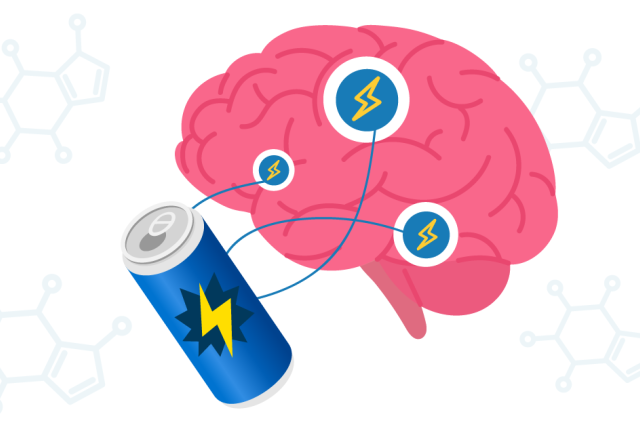As the summer ends and the new school year approaches, students face the challenges of waking up early for school and keeping their energy up throughout the day.
Adolescents are increasingly turning to energy drinks for this boost, explains Michael Garcia, MD, a clinical nutritionist at UCLA Health. From 30% of adolescents in the U.S. to as many as 70% in Europe report regular consumption of energy drinks, according to recent studies by the and .
Colorful packaging, candy-like flavorings, widespread availability and targeted marketing may have contributed to this recent trend. Many brands sponsor beloved sports teams or partner with TikTok and YouTube influencers, such as Logan Paul, due to its high caffeine content last month.
Energy drinks can pose serious health concerns for children of this age, doctors agree. However, there are steps parents can follow to make sure your child is boosting energy safely.
How much caffeine is safe?
The current recommendation for adolescents ages 12-18 is less than 100 mg of caffeine per day, according to the American Academy of Pediatrics. Energy drinks can contain 100-200 mg of caffeine per serving.
Consuming high amounts of caffeine can be risky for adolescents. Caffeine acts as a stimulant to increase alertness, and combined with the sugar found in energy drinks, works to create a “jolt” of energy, Dr. Garcia explains. The high can include side effects such as increases in heart rate and blood pressure, jitters and insomnia, quickly followed by a crash.
Depending on the frequency with which they consume energy drinks, adolescents can develop a dependence on that high, according to Dr. Garcia.
“It’s hard to break that cycle, which may lead to withdrawal symptoms like a headache or depressed mood,” he says.
And for adolescents already facing mental illnesses, these effects can be heightened.
What to look out for
The first step to healthy caffeine usage begins in the store. There are several ingredients parents can inform their kids to look out for when purchasing caffeinated beverages.
First, look out for the amount of caffeine in a serving.
“Energy drinks can contain anywhere from the same amount of caffeine as one cup of coffee to the amount in three to four cups of coffee,” Dr. Garcia says. One cup of coffee has about 75 mg of caffeine.
Energy drinks also contain several other additives, such as amino acids like taurine, added sugars and other vitamins to help provide that temporary boost of energy.
Taurine is an essential amino acid for babies, but adolescents and adults naturally produce it and don’t necessarily need to consume more of it, Dr. Garcia says. Additional herbs and vitamins such as ginseng, ginkgo biloba and others do not usually pose a risk.
Added sugars, however, act as an “upper” – providing a short-term boost of energy – but add “no nutritional value, and have the downside of causing major fluctuations in blood sugar,” says Dr. Garcia.
“I would advise against any added sugars as well as artificial sweeteners like aspartame, and sucralose” Dr. Garcia says. Research is still being conducted to determine the potential long-term harmful effects of artificial sweeteners.
The quick boost of energy these drinks provide isn't sustainable long term, says Dr. Garcia. All of the benefits to be gained from energy drinks can be found on a more sustainable basis in a well-balanced diet.
If it is necessary to consume caffeine, natural sources of caffeine, such as plain tea and coffee without added sugars, are likely healthier choices, as they are free from the additives found in energy drinks, Dr. Garcia says.
For adults, the additional health benefits of tea and coffee have been proven. However, parents should know there is not much data on the health effects for adolescents and kids.
Breaking the cycle
Many adolescents may already be facing a caffeine dependence. There are safe ways to start lowering reliance on caffeine.
Parents can begin by having an honest discussion with their kids about the root issues they are trying to address with caffeine, such as tiredness or difficulty concentrating. Many of these problems can be solved without caffeine more sustainably, such as with proper sleep hygiene, adequate protein intake and exercise.
For kids who use caffeine more regularly, the effects of withdrawal might be more of a concern. These symptoms depend on how much caffeine the adolescent is used to consuming.
“An adolescent drinking two energy drinks a day, versus drinking them once a week, is more likely to experience withdrawal headaches,” Dr. Garcia says. “Apart from headaches, they may experience changes in mood or difficulty sleeping.”
Breaking the cycle can start with gradually reducing caffeine intake.
“It’s similar to any other (addictive) substance, but to a lesser degree,” Dr. Garcia says. “Stopping cold turkey is uncomfortable, but not dangerous.”
Approaching the conversation with honesty and not focusing only on the negatives can help the message of healthy intake come across.
“Listen to your child, acknowledge the benefits they are seeking, but share your concerns for long-term use and the impacts of added ingredients,” says Dr. Garcia.
If your child persistently faces issues with alertness and tiredness, you can make an appointment with your child's primary care physician for additional advice.
Maanasi Kademani is the author of this article.




